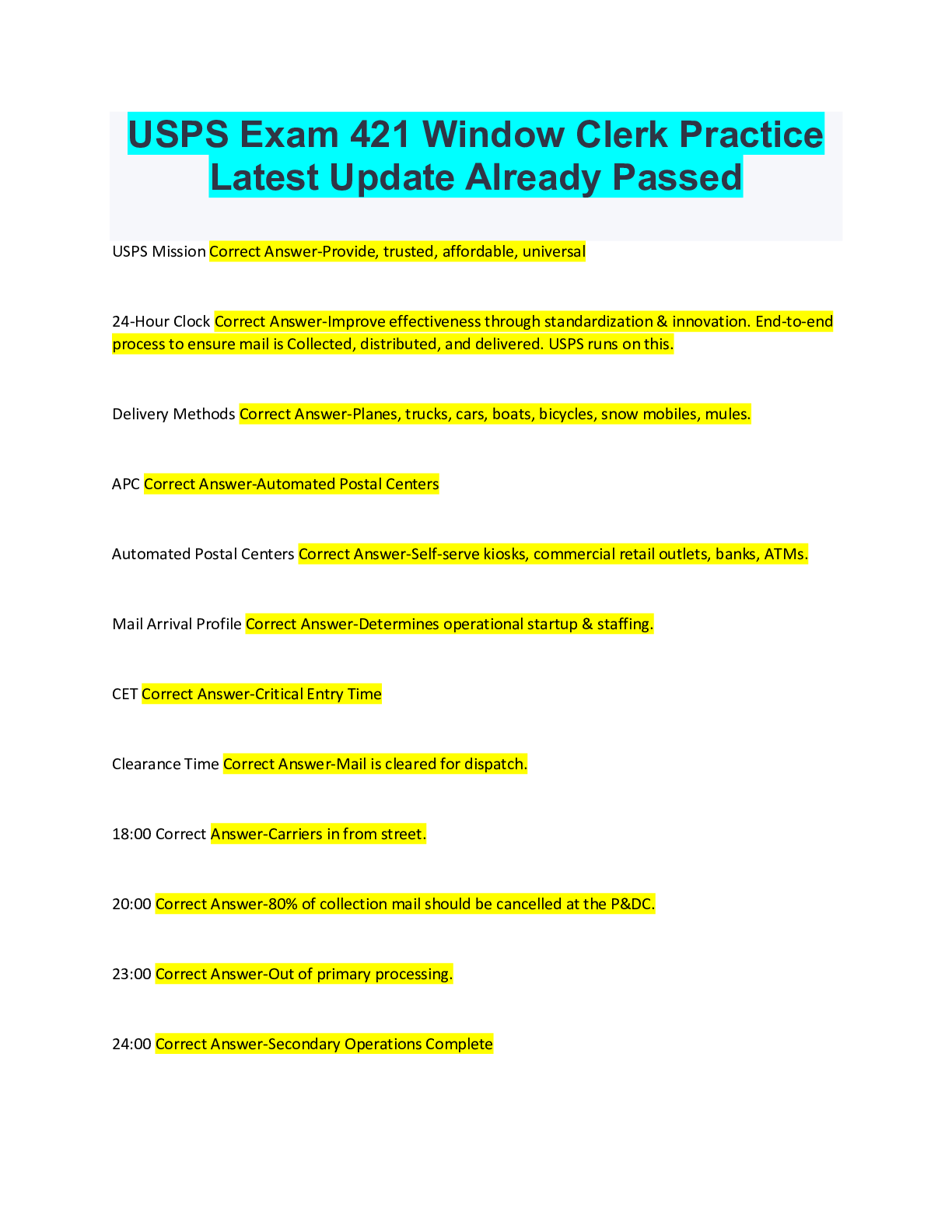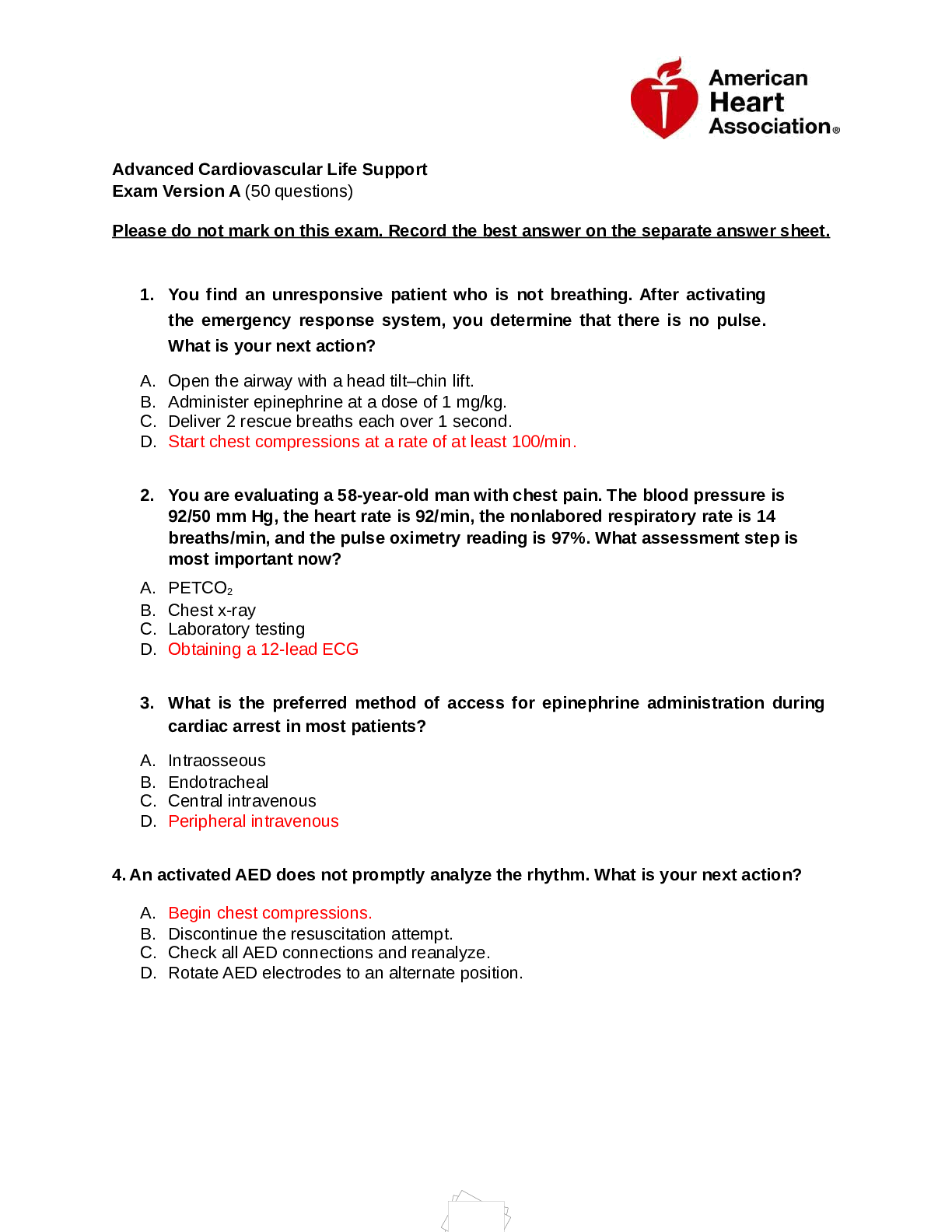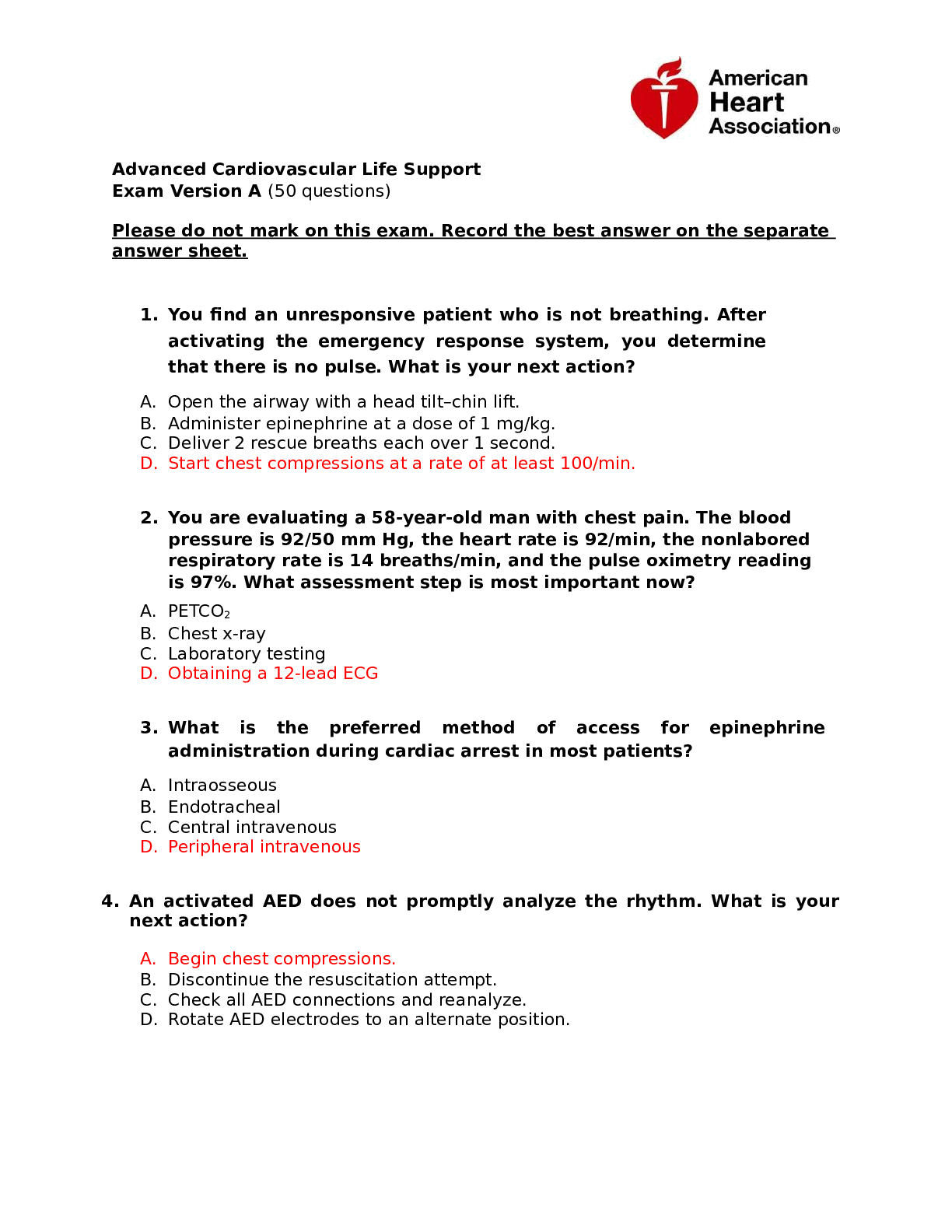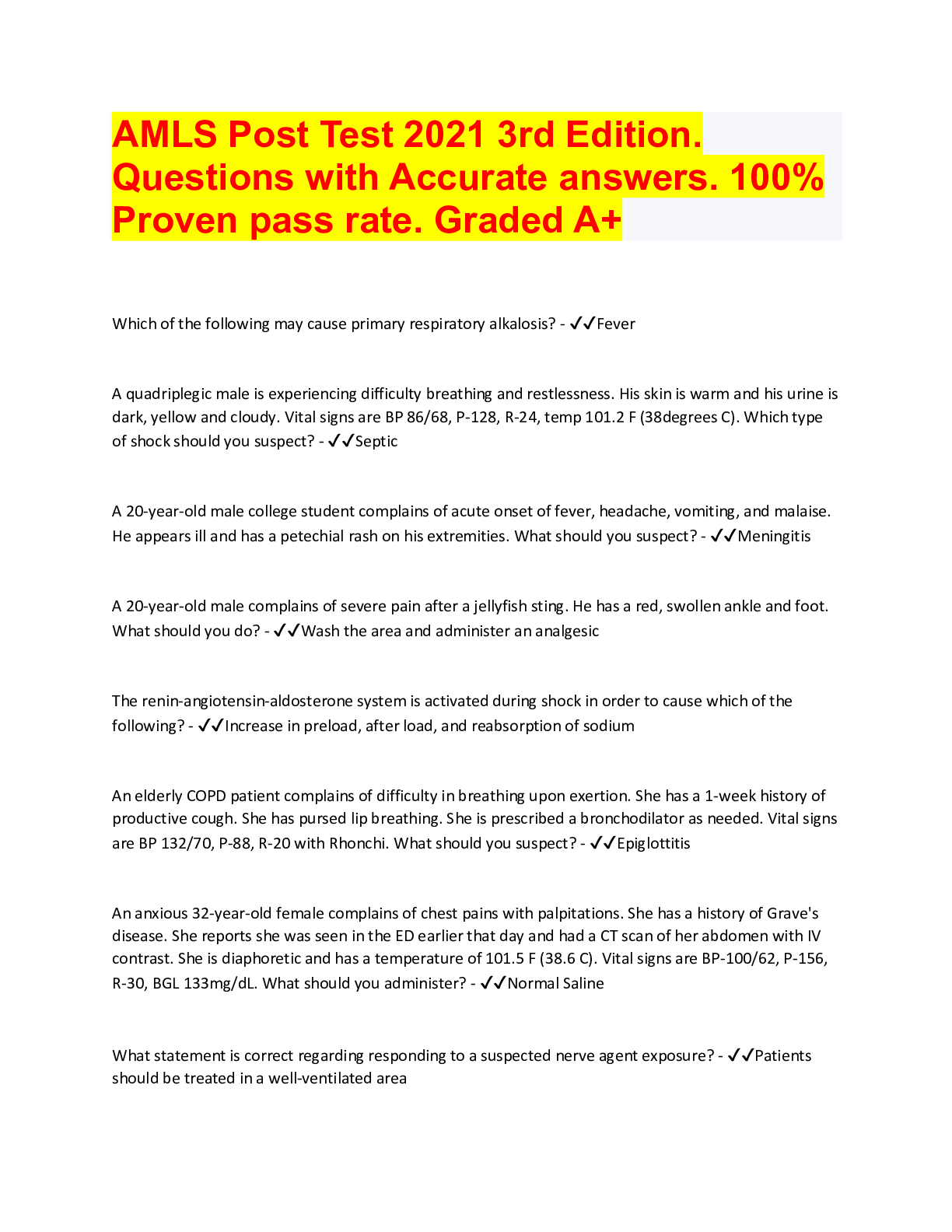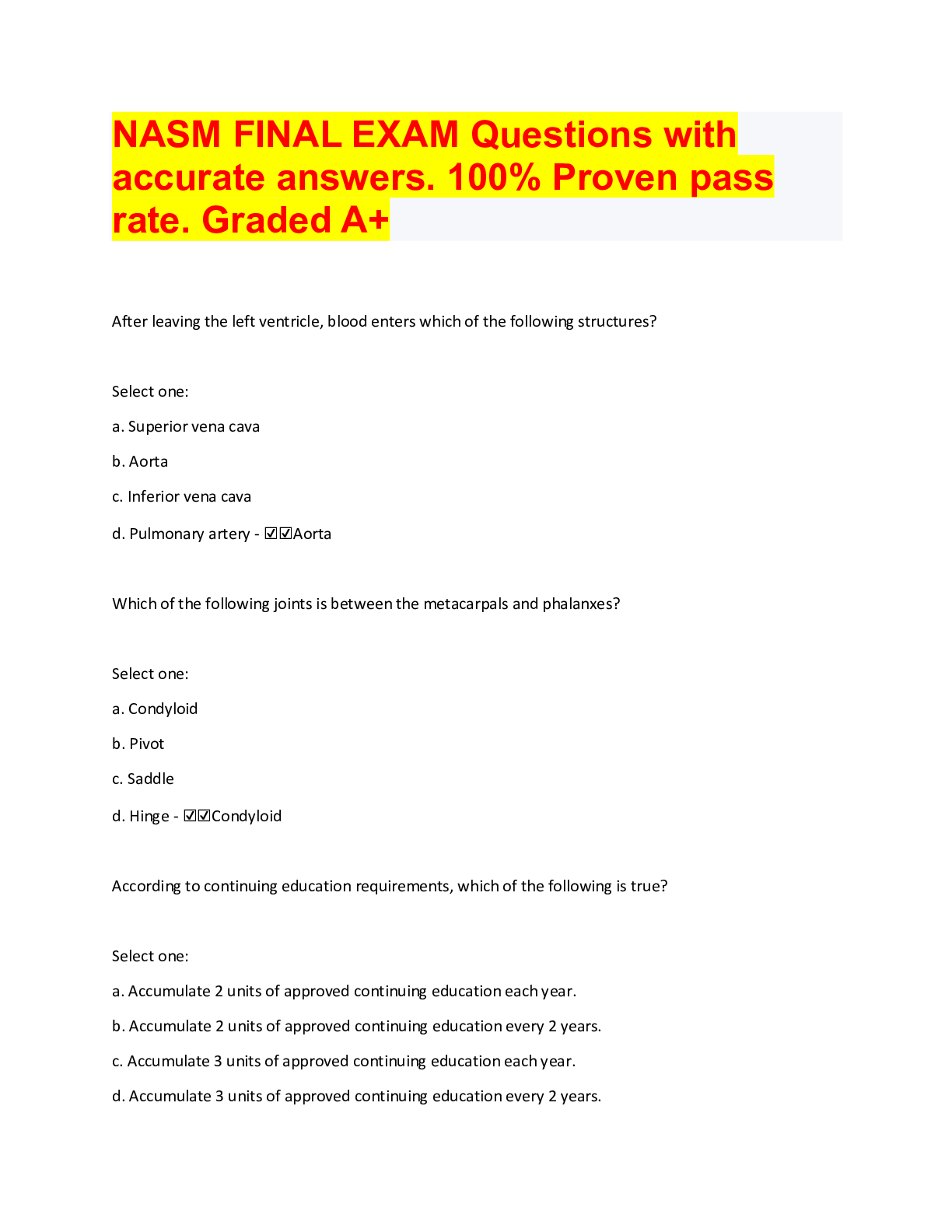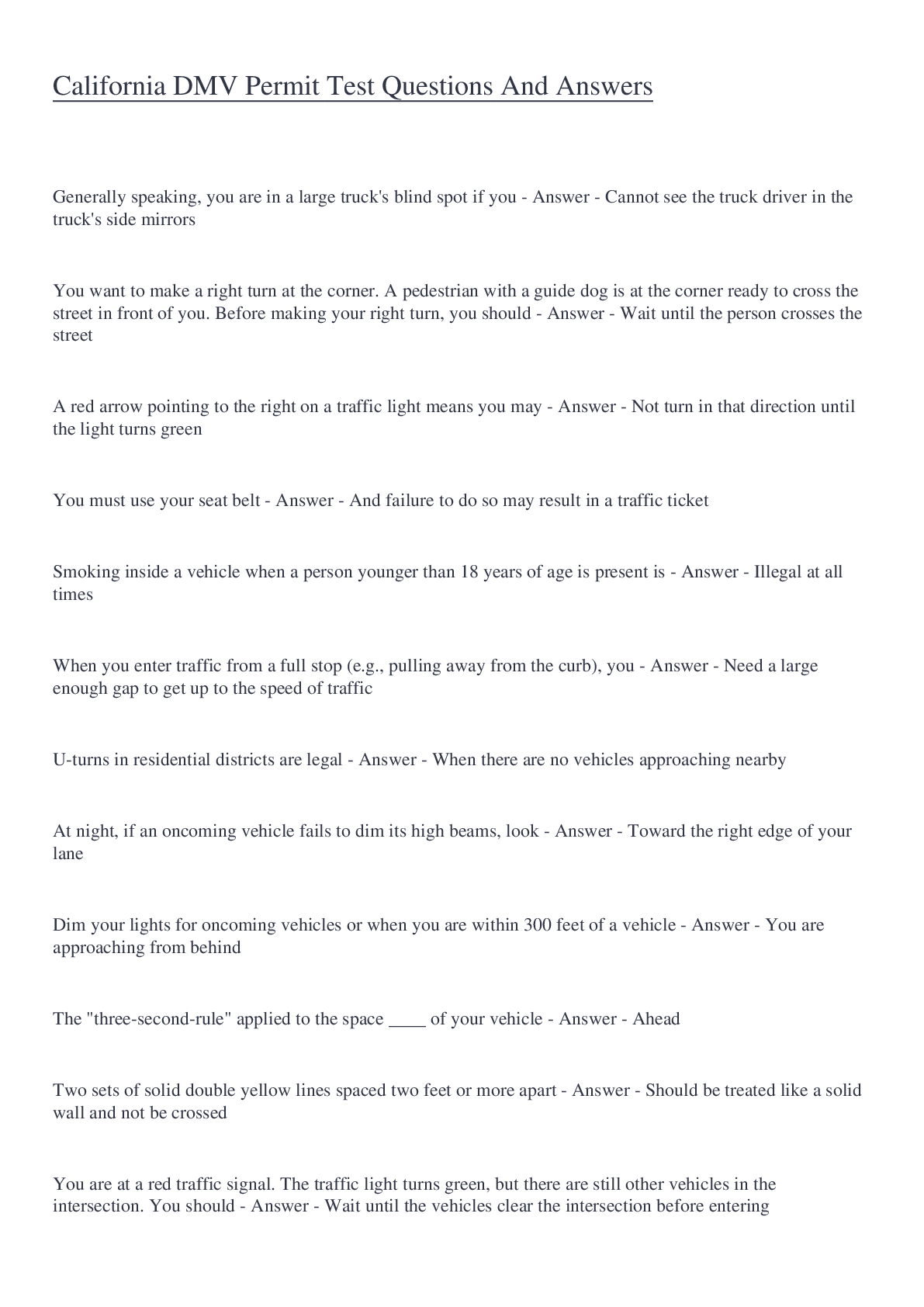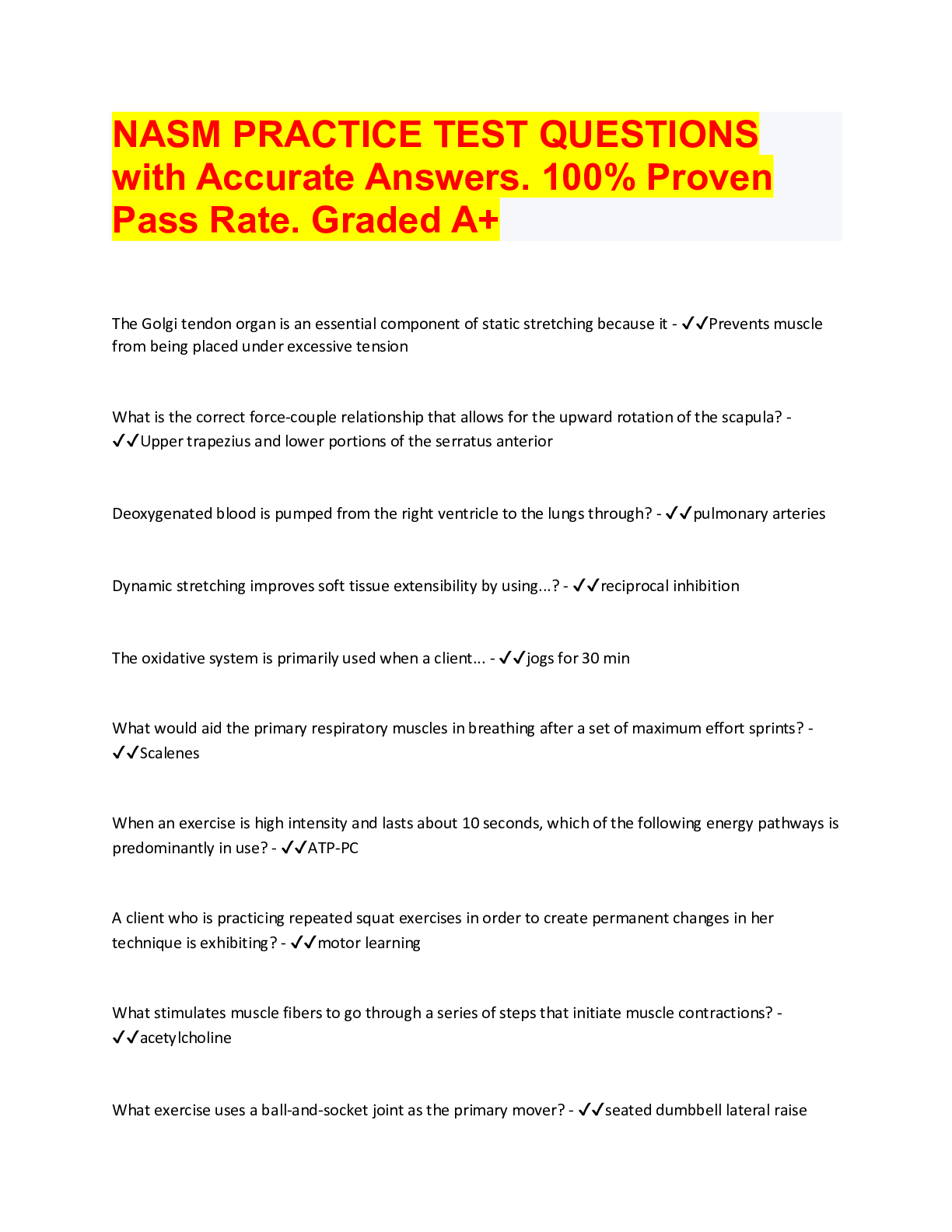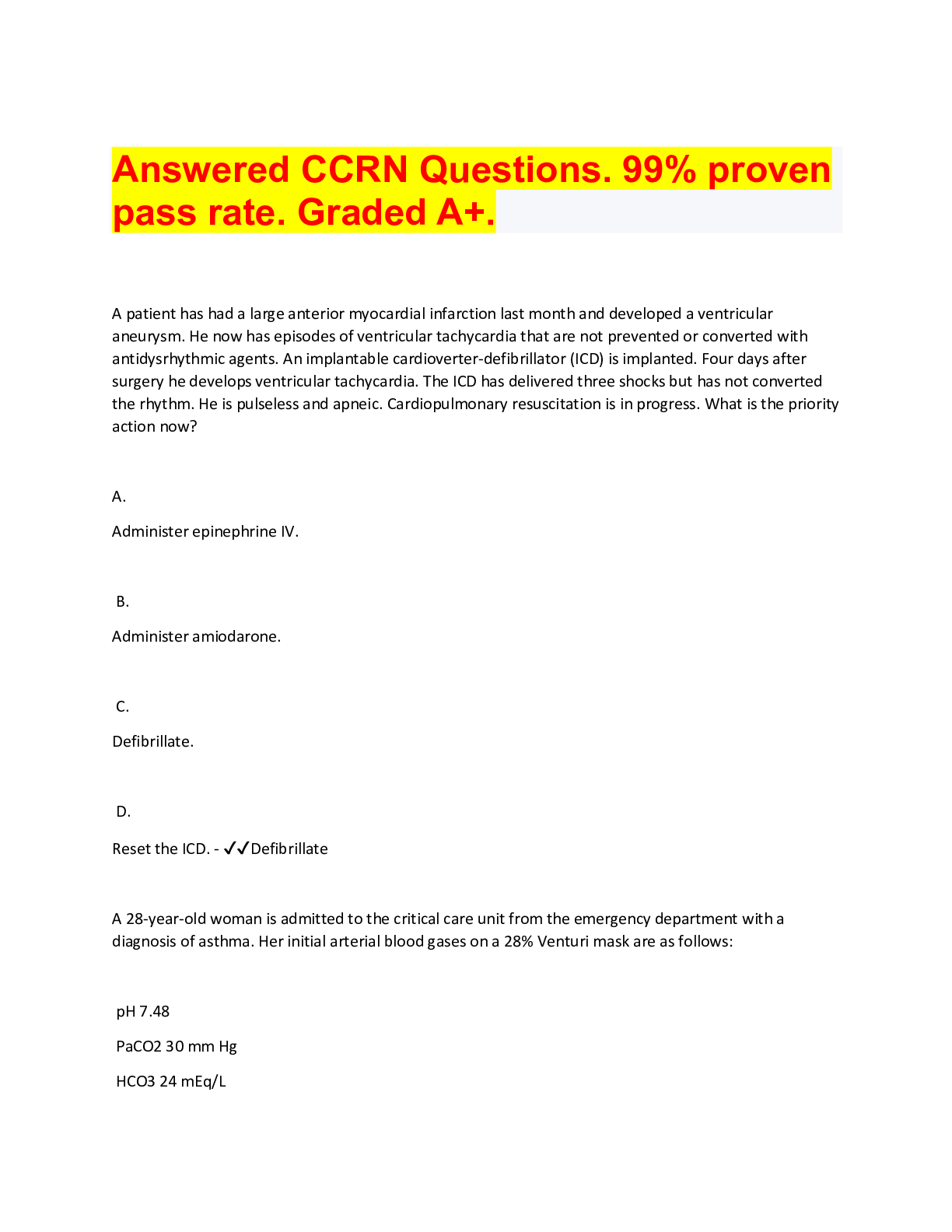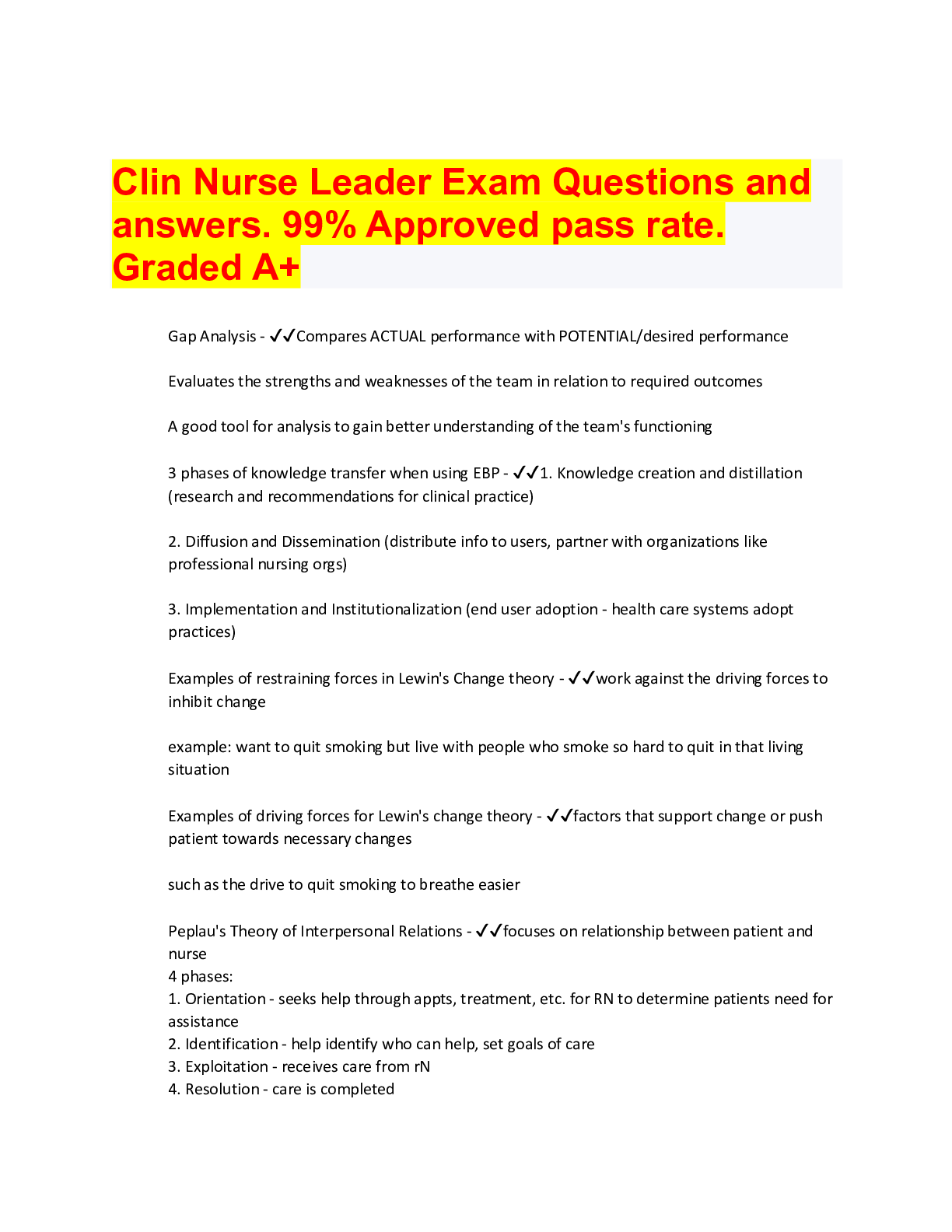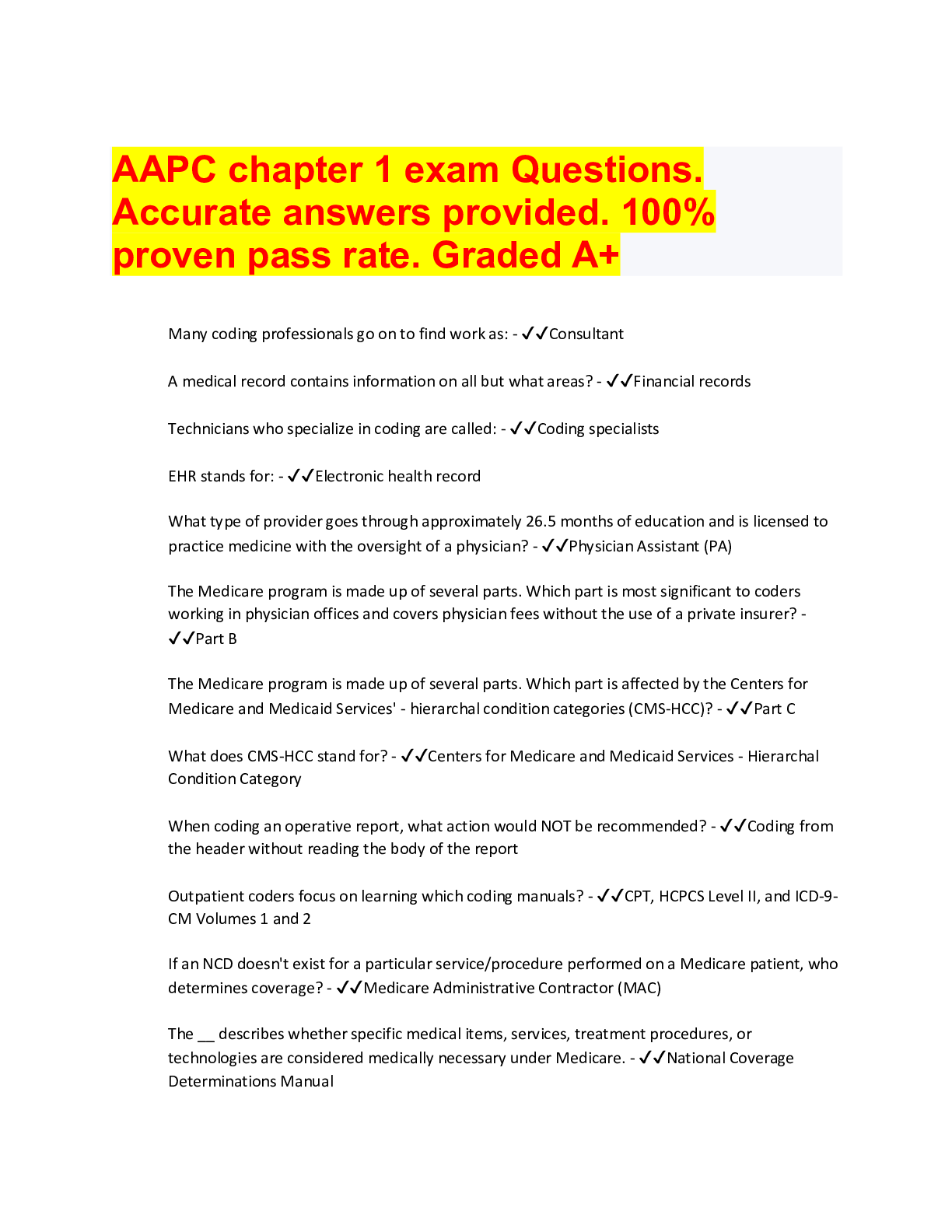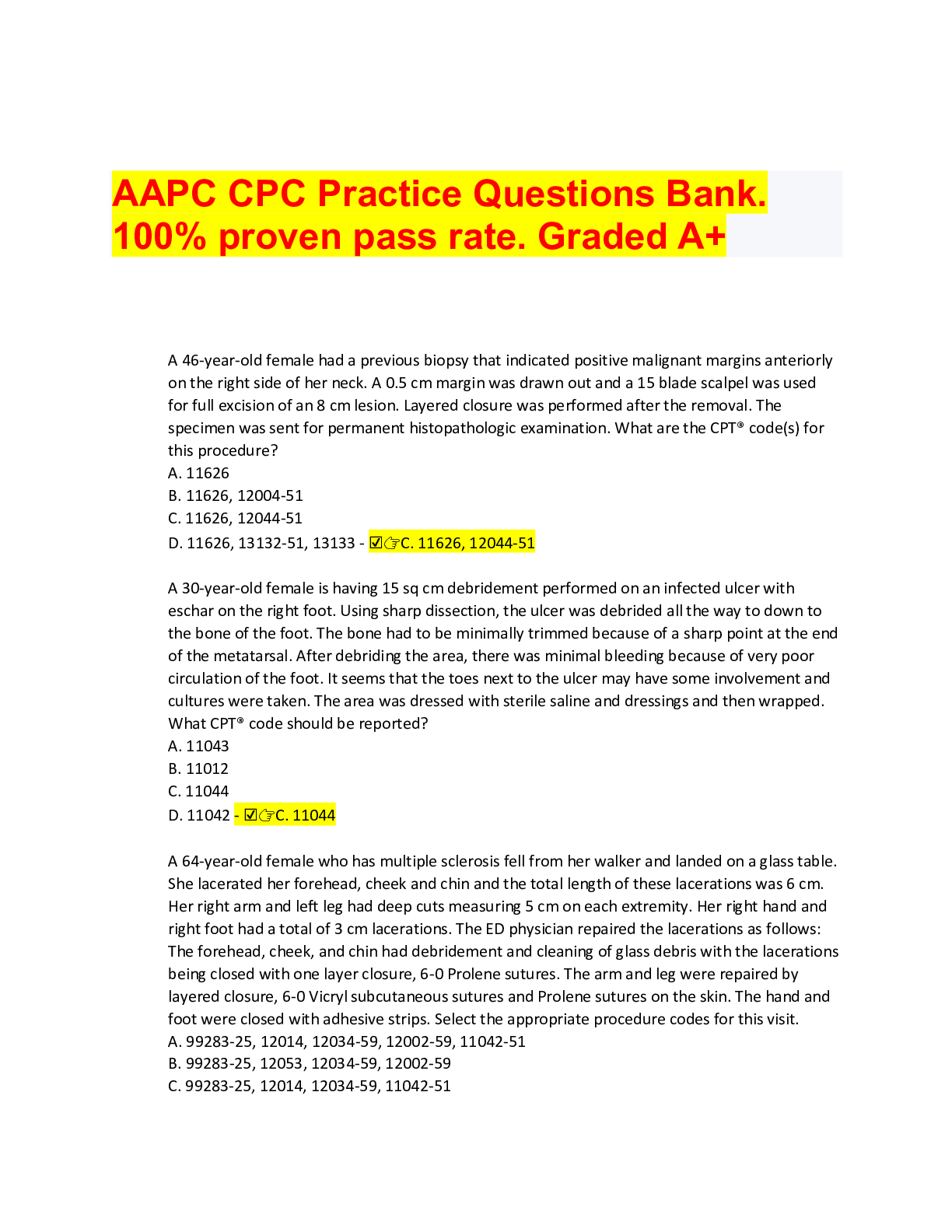*NURSING > QUESTIONS & ANSWERS > Advanced Cardiovascular Life Support Exam Version B (50 questions) 100% proven pass rate. Graded + (All)
Advanced Cardiovascular Life Support Exam Version B (50 questions) 100% proven pass rate. Graded +
Document Content and Description Below
Advanced Cardiovascular Life Support Exam Version B (50 questions) Advanced Cardiovascular Life Support Exam Version B (50 questions) Please do not mark on this exam. Record the best answer on the... separate answer sheet. 1. What should be done to minimize interruptions in chest compressions during CPR? A. Perform pulse checks only after defibrillation. B. Continue CPR while the defibrillator is charging. C. Administer IV medications only when breaths are given. D. Continue to use AED even after the arrival of a manual defibrillator. 2. Which condition is an indication to stop or withhold resuscitative efforts? A. Unwitnessed arrest B. Safety threat to providers C. Patient age greater than 85 years D. No return of spontaneous circulation after 10 minutes of CPR 3. After verifying the absence of a pulse, you initiate CPR with adequate bag-mask ventilation. The patient’s lead II ECG appears below. What is your next action? A. IV or IO access B. Endotracheal tube placement C. Consultation with cardiology for possible PCI D. Application of a transcutaneous pacemaker 4. After verifying unresponsiveness and abnormal breathing, you activate the emergency response team. What is your next action? A. Retrieve an AED. B. Check for a pulse. C. Deliver 2 rescue breaths. D. Administer a precordial thump.5. What is the recommendation on the use of cricoid pressure to prevent aspiration during cardiac arrest? A. Not recommended for routine use B. Recommended during every resuscitation attempt C. Recommended when the patient is vomiting D. Recommended only for supraglottic airway insertion 6. What survival advantages does CPR provide to a patient in ventricular fibrillation? A. Increases the defibrillation threshold B. Directly restores an organized rhythm C. Opposes the harmful effects of epinephrine D. Produces a small amount of blood flow to the heart 7. What is the recommended compression rate for performing CPR? A. 60 to 80 per minute B. 80 to 100 per minute C. About 100 per minute D. At least 100 per minute 8. EMS personnel arrive to find a patient in cardiac arrest. Bystanders are performing CPR. After attaching a cardiac monitor, the responder observes the following rhythm strip. What is the most important early intervention? A. Defibrillation B. Endotracheal intubation C. Epinephrine administration D. Antiarrhythmic administration 9. A patient remains in ventricular fibrillation despite 1 shock and 2 minutes of continuous CPR. The next intervention is to A. administer amiodarone. B. administer a second shock. C. administer epinephrine. D. insert an advanced airway.10. What is the recommended next step after a defibrillation attempt? A. Open the patient’s airway. B. Determine if a carotid pulse is present. C. Check the ECG for evidence of a rhythm. D. Begin CPR, starting with chest compressions. 11. Which of the following is the recommended first choice for establishing intravenous access during the attempted resuscitation of a patient in cardiac arrest? A. Subclavian vein B. Antecubital vein C. Intraosseous line D. Internal jugular vein 12. What is the recommended first intravenous dose of amiodarone for a patient with refractory ventricular fibrillation? A. 1 mg B. 1 mg/kg C. 1 mEq/kg D. 300 mg 13. IV/IO drug administration during CPR should be A. given rapidly during compressions. B. administered slowly during the pause for a pulse check. C. given by infusion. D. given before any defibrillation attempts. 14. How often should the team leader switch chest compressors during a resuscitation attempt? A. Every minute B. Every 2 minutes C. Every 3 minutes D. Every 4 minutes 15. Which finding is a sign of ineffective CPR? A. PETCO2 <10 mm Hg B. Patient temperature >32°C (89.6°F) C. Diastolic intra-arterial pressure ≥20 mm Hg D. Measured patient urine output of 1 mL/kg per hour16. A team leader orders 1 mg of epinephrine, and a team member verbally acknowledges when the medication is administered. What element of effective resuscitation team dynamics does this represent? A. Clear messages B. Knowing one’s limitations C. Closed-loop communication D. Clear roles and responsibilities 17. How long should it take to perform a pulse check during the BLS Survey? A. 1 to 5 seconds B. 5 to 10 seconds C. 10 to 15 seconds D. 15 to 20 seconds 18. Your rescue team arrives to find a 59-year-old man lying on the kitchen floor. You determine that he is unresponsive and notice that he is taking agonal breaths. What is the next step in your assessment and management of this patient? A. Apply the AED. B. Check the patient’s pulse. C. Open the patient’s airway. D. Check for the presence of breathing. 19. Which treatment or medication is appropriate for the treatment of a patient in asystole? A. Atropine B. Epinephrine C. Defibrillation D. Transcutaneous pacing 20. An AED advises a shock for a pulseless patient lying in snow. What is the next action? A. Place a backboard beneath the patient and administer the shock. B. Move the patient off the snow to bare ground and deliver the shock. C. Remove any snow beneath the patient and then administer the shock. D. Advanced Cardiovascular Life Support Exam Version B (50 questions) Please do not mark on this exam. Record the best answer on the separate answer sheet. 1. What should be done to minimize interruptions in chest compressions during CPR? A. Perform pulse checks only after defibrillation. B. Continue CPR while the defibrillator is charging. C. Administer IV medications only when breaths are given. D. Continue to use AED even after the arrival of a manual defibrillator. 2. Which condition is an indication to stop or withhold resuscitative efforts? A. Unwitnessed arrest B. Safety threat to providers C. Patient age greater than 85 years D. No return of spontaneous circulation after 10 minutes of CPR 3. After verifying the absence of a pulse, you initiate CPR with adequate bag-mask ventilation. The patient’s lead II ECG appears below. What is your next action? A. IV or IO access B. Endotracheal tube placement C. Consultation with cardiology for possible PCI D. Application of a transcutaneous pacemaker 4. After verifying unresponsiveness and abnormal breathing, you activate the emergency response team. What is your next action? A. Retrieve an AED. B. Check for a pulse. C. Deliver 2 rescue breaths. D. Administer a precordial thump.5. What is the recommendation on the use of cricoid pressure to prevent aspiration during cardiac arrest? A. Not recommended for routine use B. Recommended during every resuscitation attempt C. Recommended when the patient is vomiting D. Recommended only for supraglottic airway insertion 6. What survival advantages does CPR provide to a patient in ventricular fibrillation? A. Increases the defibrillation threshold B. Directly restores an organized rhythm C. Opposes the harmful effects of epinephrine D. Produces a small amount of blood flow to the heart 7. What is the recommended compression rate for performing CPR? A. 60 to 80 per minute B. 80 to 100 per minute C. About 100 per minute D. At least 100 per minute 8. EMS personnel arrive to find a patient in cardiac arrest. Bystanders are performing CPR. After attaching a cardiac monitor, the responder observes the following rhythm strip. What is the most important early intervention? A. Defibrillation B. Endotracheal intubation C. Epinephrine administration D. Antiarrhythmic administration 9. A patient remains in ventricular fibrillation despite 1 shock and 2 minutes of continuous CPR. The next intervention is to A. administer amiodarone. B. administer a second shock. C. administer epinephrine. D. insert an advanced airway.10. What is the recommended next step after a defibrillation attempt? A. Open the patient’s airway. B. Determine if a carotid pulse is present. C. Check the ECG for evidence of a rhythm. D. Begin CPR, starting with chest compressions. 11. Which of the following is the recommended first choice for establishing intravenous access during the attempted resuscitation of a patient in cardiac arrest? A. Subclavian vein B. Antecubital vein C. Intraosseous line D. Internal jugular vein 12. What is the recommended first intravenous dose of amiodarone for a patient with refractory ventricular fibrillation? A. 1 mg B. 1 mg/kg C. 1 mEq/kg D. 300 mg 13. IV/IO drug administration during CPR should be A. given rapidly during compressions. B. administered slowly during the pause for a pulse check. C. given by infusion. D. given before any defibrillation attempts. 14. How often should the team leader switch chest compressors during a resuscitation attempt? A. Every minute B. Every 2 minutes C. Every 3 minutes D. Every 4 minutes 15. Which finding is a sign of ineffective CPR? A. PETCO2 <10 mm Hg B. Patient temperature >32°C (89.6°F) C. Diastolic intra-arterial pressure ≥20 mm Hg D. Measured patient urine output of 1 mL/kg per hour16. A team leader orders 1 mg of epinephrine, and a team member verbally acknowledges when the medication is administered. What element of effective resuscitation team dynamics does this represent? A. Clear messages B. Knowing one’s limitations C. Closed-loop communication D. Clear roles and responsibilities 17. How long should it take to perform a pulse check during the BLS Survey? A. 1 to 5 seconds B. 5 to 10 seconds C. 10 to 15 seconds D. 15 to 20 seconds 18. Your rescue team arrives to find a 59-year-old man lying on the kitchen floor. You determine that he is unresponsive and notice that he is taking agonal breaths. What is the next step in your assessment and management of this patient? A. Apply the AED. B. Check the patient’s pulse. C. Open the patient’s airway. D. Check for the presence of breathing. 19. Which treatment or medication is appropriate for the treatment of a patient in asystole? A. Atropine B. Epinephrine C. Defibrillation D. Transcutaneous pacing 20. An AED advises a shock for a pulseless patient lying in snow. What is the next action? A. Place a backboard beneath the patient and administer the shock. B. Move the patient off the snow to bare ground and deliver the shock. C. Remove any snow beneath the patient and then administer the shock. D. Administer the shock immediately and continue as directed by the AED.Administer the shock immediately and continue as directed by the AED. [Show More]
Last updated: 1 year ago
Preview 1 out of 15 pages
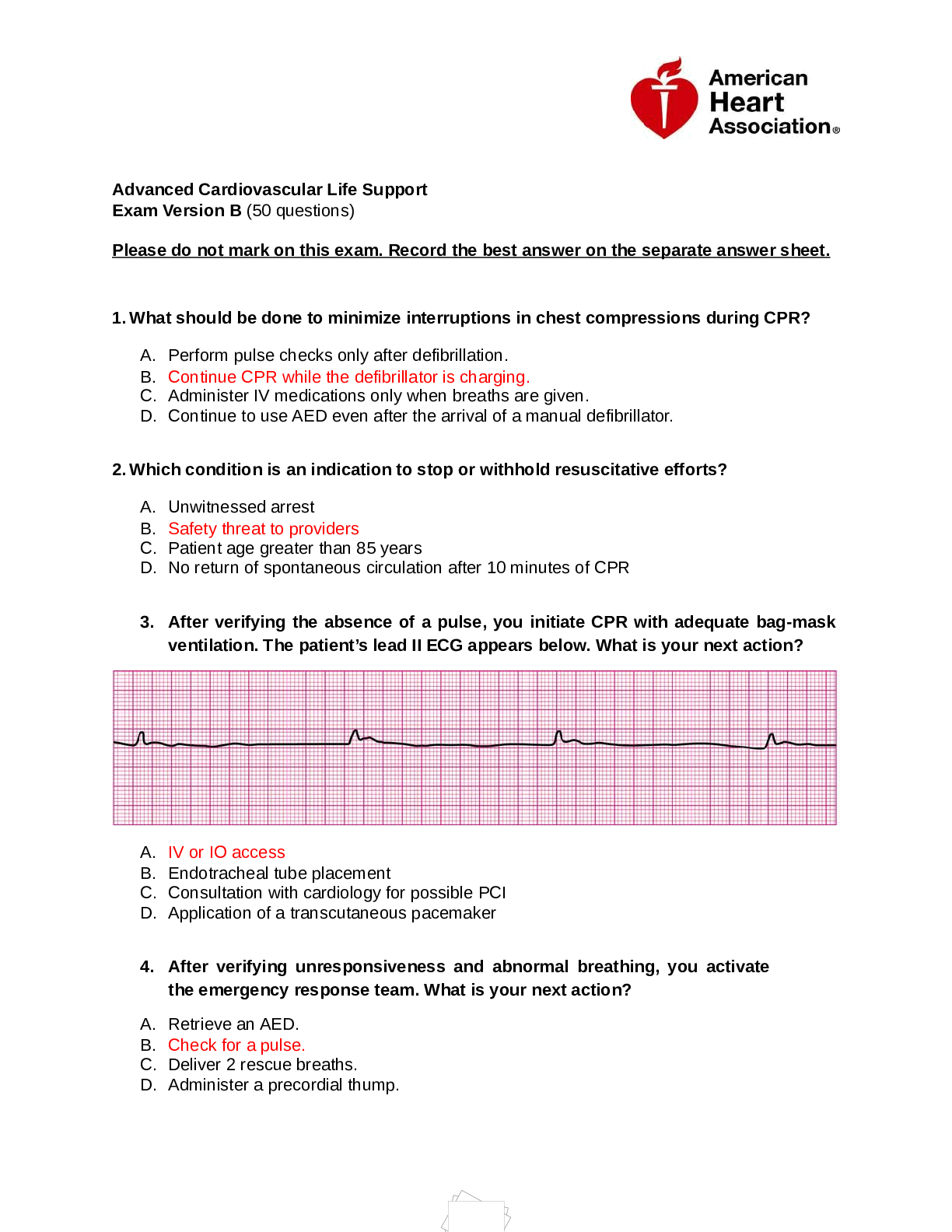
Reviews( 0 )
Document information
Connected school, study & course
About the document
Uploaded On
Aug 29, 2022
Number of pages
15
Written in
Additional information
This document has been written for:
Uploaded
Aug 29, 2022
Downloads
1
Views
343














